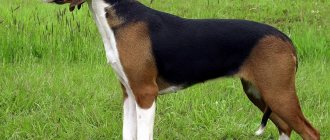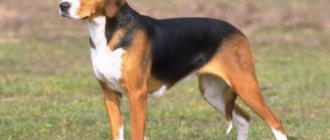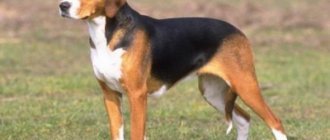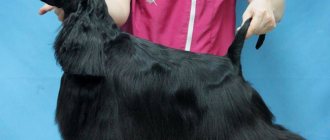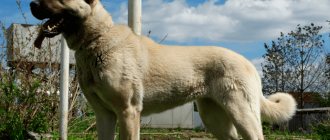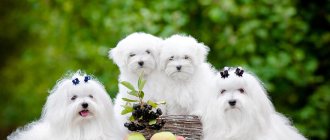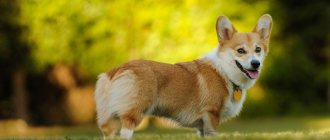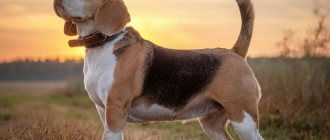| Intelligence: |
| Aggressiveness: |
| For security: |
| For children: |
| Training: |
| Difficulty in care: |
The Polish Ogar (Polish hound) belongs to the hunting breed of dogs, specializing in elk, wild boar, foxes, roe deer and hares. Thanks to their keen sense of smell, energy and endurance, these dogs are an indispensable assistant in hunting. They are able to hunt in any terrain and in any weather conditions. In a pack they behave amicably and do not show aggression towards other breeds, so when hunting, ogars are often combined with huskies and other dogs.
History of the breed and its recognition
Initially, such dogs were bred in Mazovia and the southern regions of the country (Podhale, Bieszczady and others). The first mention of the breed in literature was in the thirteenth century. Already in the sixteenth century, hunting with hounds became popular among the Polish gentry. This breed appeared in Russia in 1812, after World War II. Then the officers brought with them various trophies, including Polish hounds.
The reason for the popularity of this breed in our country lies in the fashion for everything foreign. The development of the gun method of hunting with a hound in the “French style” also contributed to the success of the breed. These dogs were convenient for such an activity because they were distinguished by their extraordinary viscosity. If such a dog picks up a hare, he will hold it all day.
In 1939, at the second cynological congress, many breeds of hounds were banned, including the Polish one. During World War II, purebred dog breeding in Eastern Europe and Poland was almost destroyed. At that difficult time, the number of hounds was practically lost.
In the second half of the twentieth century, Poland began to recreate lost dog species. When registering the breed in the FCI in 1996, the Polish Hound was rejected. This type of hunting dog was removed from purebred breeding for a long time.
Although hunters still used such dogs for their excellent working qualities. By 1976, there were already 101 dogs of this species.
Seven years later, the Polish Canine Union prepared a breed standard for the Polish Hound. The first representatives of the breed with a full pedigree were born in 1989. And in 2017, the Polish Hound was recognized by the FCI on a permanent basis.
Mating
Breeding mating for Russian hounds is mandatory for the formation of a single livestock and an entire breed line. In their absence, the breed is not recognized by international organizations. Therefore, it is recommended to bring pets through official breeders, obtain certificates for mating and fill out special forms.
- To determine the approximate date you need to know the girl’s cycles.
- Puberty comes early to puppies (8-10 months). The first heat usually occurs at this time.
- It is recommended to start mating at 2 years of age, when dogs are able to bear healthy offspring.
- On days 13-15 of the third heat, some symptoms should appear.
- The previously swollen and hard loop becomes loose and soft, the discharge becomes lighter, the female invites the male with her tail, and becomes playful or aggressive.
- On the appointed day, the animals are walked together and taken to the territory of the male dog. The girl will allow you to do the cage when she is ready.
- During the uncoupling (the first time), the animals are helped: they support the female under the belly, and the male is directed into the loop. Sometimes a specially trained person is invited.
- The absence of a lock is not a reason to worry. This does not mean that the act was unsuccessful and the female is empty.
- Fixative mating is carried out after 48 hours.
Head and general appearance
The dog of this breed is medium in size, compact, lean. She has a well developed bone structure. The height at the withers is about 54-57 cm.
The dog's head is proportional, with pronounced dry cheekbones. The length of the skull is equal to the length of the muzzle. The nose is black or brown, in accordance with the color. The lips of such dogs are dense and cover the lower jaw well. The corners of the mouth are clearly marked. The teeth are straight, white, strong. These dogs have a scissor bite.
The eyes of Polish hounds are medium in size and slightly slanted. Dark in color, in accordance with the color. The eyelids fit tightly.
The ears are medium in size, triangular in shape, not thick, with rounded tips. At the base they are wide, set quite low, approximately at the level of the outer corner of the eyes. The ears fit tightly to the cheekbones. Their fur is silky and smooth.
Links[edit]
- Gino Pugnetti, Elizabeth Meriwether Schuler. Simon and Schuster's Guide to Dogs
. Simon and Schuster. 1980. p. 145. - Bonnie Wilcox, Chris Walkowicz. Atlas of dog breeds of the world
. TFH Publications. 1995. p. 681 - FCI Polish Hound
- ^ a b
Ria Hurter.
“New dog breeds are recognized by the FCI. Gończy Polski (Polish hunting dog).” Dog Chronicle
. October 2013, pp. 196–199. - "Polish Hound". Sarah's Dogs website. April 12, 2012. Retrieved 5 Feb 2013.
- "Polish Hound (Ogar Polski)".
- "Polish hounds".
Bibliography[edit]
- "Polish Hound (Ogar Polski)." Elite Pets. N. P., N. D. Web. February 18, 2013
- "Polish Hound" A network of furry creatures. Bryntel Technologies, n.d. Web. February 05, 2013
- "Polish Hound". Saras Dogs. Sarah's Dogs website, April 12, 2012. Internet. February 05, 2013
- "Polish Hound" United Kennel Club: Polish Hound. United Kennel Club, Inc., n.d. Web. February 05, 2013
- "Polish hounds". GotPetsOnline.com. GotPetsOnline.com, February 18, 2013. Internet. February 21, 2013
Limbs
The limbs are straight, parallel, muscular and bony. Note that the height at the elbow is approximately half the height of the animal at the withers. The shoulder blade is slanted, long, and the forearms are straight. Strong elbows are pressed tightly to the body, pointing down.
The hind limbs of these dogs are parallel and straight. The angles of articulation are very pronounced on them. The hips of such dogs are wide and muscular. Note that representatives of the breed do not have dewclaws.
The paws are oval, tightly compressed, large. The claws are usually dark in color and point downwards.
Character
The German Hound has a calm and cool disposition, is friendly and loyal. Aggressive behavior is not typical for representatives of the breed
Dogs get along well with all members of the family, but they show wariness and increased attention to strangers, since they make it their duty to protect the owner and his family from uninvited guests
It requires a respectful attitude, without which the animal simply does not make contact with a person and shows maximum willfulness. They are emotionally sensitive, and therefore any slightest change in the tone of conversation and behavior of the owner will be picked up by the dog.
Maintenance and care
After hunting, you should thoroughly clean the fur of debris and thorns that are stuck in it. Note that it is necessary to brush your Polish Hound daily. You will never need to cut such a dog. It should only be washed when necessary. These dogs are unpretentious in care.
Of course, Polish hounds need fresh air and great physical activity. Therefore, it is best to keep such dogs in an enclosure or in the yard. But since these dogs are quite compact in size, they will be comfortable living in an apartment. But in this case, long walks are required.
During the molting period, you need to pay special attention to the animal's fur. You should comb it thoroughly with a stiff brush.
In dogs such as Polish hounds, hereditary mental illnesses have not been observed. Life expectancy is on average 13-14 years.
Diseases of the Polish Hound
The average lifespan of the Polish Ogar is 12–14 years. Representatives of the breed are distinguished by strong immunity and excellent health, which makes them excellent hunting companions in any weather. But such dogs have a weak point - drooping ears. Moisture that gets into the sink creates a favorable environment for the development of bacteria, and scratches or twigs and other debris that go unnoticed by the owner injure delicate tissues, aggravating the situation. For Polish sturgeons, the most common health problem is otitis media. The disease can be recognized by the following signs:
- the dog scratches its ear;
- tilts his head to the side;
- rubs his ear on the ground;
- shakes his head.
Treatment should be carried out as prescribed by a veterinarian depending on the identified cause. The dog may only need rinsing and cleaning of the ear, and perhaps a course of antibiotics (if the form is bacterial). It is impossible to leave otitis media without treatment - the spreading inflammation will move deeper into the ear and can cause serious consequences, in particular, hearing loss or inflammation of the lining of the brain.
The Polish Ogar is a hunting breed that belongs to the category of large hounds. These are kind and calm dogs that do not show aggression outside of working for the animal. These pets require a lot of activity, but are otherwise very easy to keep.
Nutrition
When preparing a diet for hounds, it is very important to take into account the fact that they have a high need for protein components. In winter, in order to increase the calorie content of the dish, it is worth adding a little animal fat. With minimal weight, a dog of this breed should consume about 350 grams of meat per day. If it has the maximum allowable weight for a given type, then you will need to increase the amount of product to half a kilogram. You can diversify your diet with low-fat dairy products. You need to add some cereals, vegetables and fresh herbs to your dog’s diet.
Purchasing a cinder
You can buy a puppy of this breed, brought from Poland, for 1,400 – 1,600 Euros . It is not difficult to find advertisements for the sale of puppies from Russian manufacturers with prices ranging from 60,000 to 120,000 rubles .
It is important to familiarize yourself in advance with the list of documents indicating that the puppy is purebred. The owner must provide the buyer with the following documents:
- A pedigree that meets the requirements of the Fédération Cynologique Internationale.
- Certificate (metric) for the right to own a dog.
It is best to pick up a puppy at two months of age, since he is already quite strong and needs much less attention from his mother.
Breed training
Only a person who has strong leadership qualities should train a dog. Strictness in education is important. But you should also not forget about encouragement and praise. Polish hounds strive to please their owner. Therefore, they study willingly and achieve high results in training. Show excellent results in running and Frisbee competitions. When the trainer shows unjustified cruelty, the dog will demonstrate open disobedience.
Choosing a puppy
Polish Ogars are a small breed, so finding a purebred puppy is not easy. At the official nursery you will have to stand in line to wait for your baby. When choosing a dog, it is important to rely on the following criteria:
- External signs. The puppy must meet the standard, have the correct proportions (long body, deep chest, etc.), acceptable color, shape of ears and tail, etc.
- Behavior. A healthy Ogar puppy should be curious, active and playful. He may not immediately approach a stranger, but once he gets used to it, he will definitely show interest in him.
- Pedigree and health of the puppy's parents. It is necessary that the parents also be purebred and participate in exhibitions and working tests.
Polish Ogar puppies must visually meet the requirements of the breed
A puppy card will confirm your breed, a document that can later be exchanged for a pedigree. Considering the rarity of the breed, the cost per baby will be high - from 1,000–1,500 euros.
Nature
The Polish Greyhound is a reserved, reserved and brave dog.
He distances himself from strangers, but is very affectionate and affectionate towards his family. Raised with a cat, he may live with it indoors, but if he sees a cat outside, his hunting instincts will kick in. It should be remembered that the Polish Greyhound is usually not satisfied with the chase itself, but in fact it can hunt a domestic animal, so in places where free-living cats roam, it must be kept on a leash. He is not usually aggressive towards foreign dogs, but as a strong-willed dog, he can get into a fight if provoked. He also has a strong territorial instinct.
Skills
The Polish Greyhound was used to hunt various types of game - it was used for being fast, very agile and persistent in pursuit. In Podolia, the most valuable entertainment of the nobility was hunting to catch a live wolf, for which three greyhounds were used. On the other hand, two greyhounds were usually used to hunt hares, but especially capable individuals could catch them alone - they commanded the highest price.
Polish greyhounds chased game and killed it, but usually did not return it. Therefore, the hunter had to follow the dogs on horseback to collect the kill after the chase was over. Polish greyhounds were also hunted for foxes and bustards.
In the past, Polish greyhounds were distinguished - and this trait remains with them today - by obedience and discipline. They were often hunted as so-called greyhounds (or staggered), that is, those that walk freely next to the horse and chase only on command. Styling greyhounds was a great art. On command they were to pursue and return to the rider at the sound of the horn. Young greyhounds were usually trained together with older, more experienced ones.
Less obedient greyhounds were led in pairs and on a leash - these were long straps ending in a loop, which the hunter threw over his shoulder. The strap was threaded through the collars of both greyhounds, and the rider held its free end in his hand along with the reins. When he wanted to release the dogs, he threw the end of the leash to the ground, and the pursuing greyhounds were freed.
In hunting dialect, two greyhounds were called "lead". Dogs from one pair (or three) stayed together, also in the kennel. They were always carefully selected for their character, physical abilities and personal preferences. The "Leash" had to live in complete harmony, the greyhounds had to know and understand each other in order to be able to cooperate effectively in the field.
Usually two greyhounds were used for hunting, the third was kept at home or, as in the case of wolf hunting, kept in reserve until the last attack. Combining greyhounds from different “leashes” was avoided unless they were prepared for this in advance, since this usually did not give good hunting results. If one of the greyhounds was unwell, her mate also did not participate in the hunt. Each “leash” had its own urine, to which the greyhounds returned at a certain sound signal. Twenty leashes could participate in the largest hunts.
Hunting with greyhounds is currently prohibited, but the Polish greyhound is ideal for racing, especially cross-country racing (called coursing).
Training and education
With all the benefits of a Greyhound, the Polish Greyhound is also a balanced, capable dog that can be perfectly groomed. Many Polish Greyhounds have been trained as companion dogs, some of them have taken part in obedience shows and even agility competitions. The Polish Greyhound loves to work with people as long as we do not tire them out with repeated repetitions, but rather vary the exercises and reward them generously.
The Polish Greyhound is very loyal to its owner, and when properly cared for, it is a “one man dog”, an excellent companion in the home and - when necessary - a vigilant guardian of the property.
Who is this breed for?
The Polish Greyhound should go into the hands of a person who already has some experience in raising dogs and who can provide him with the right dose of exercise. The owner of this breed must be balanced and consistent.
While this dog will be content with short but intense efforts (such as coursing), he will also happily engage in other activities such as accompanying a runner or cyclist. He does best in a house with a garden (but should be given a few walks) but will also adapt to apartment life - provided his activity needs are met.
Interesting Facts
The hunting law in Poland requires permission from the warden to keep and breed greyhounds of all breeds, as well as their hybrids. The application is submitted to the municipal office in the Department of Agriculture.
For purebred dogs, pedigree documents or a birth certificate (if the animal is not registered) are most often required. You will also need information about age, gender, race, color and tattoo or chip number. An application requesting permission must also be attached. Sometimes officials will also request a veterinary certificate confirming the dog's general health.

